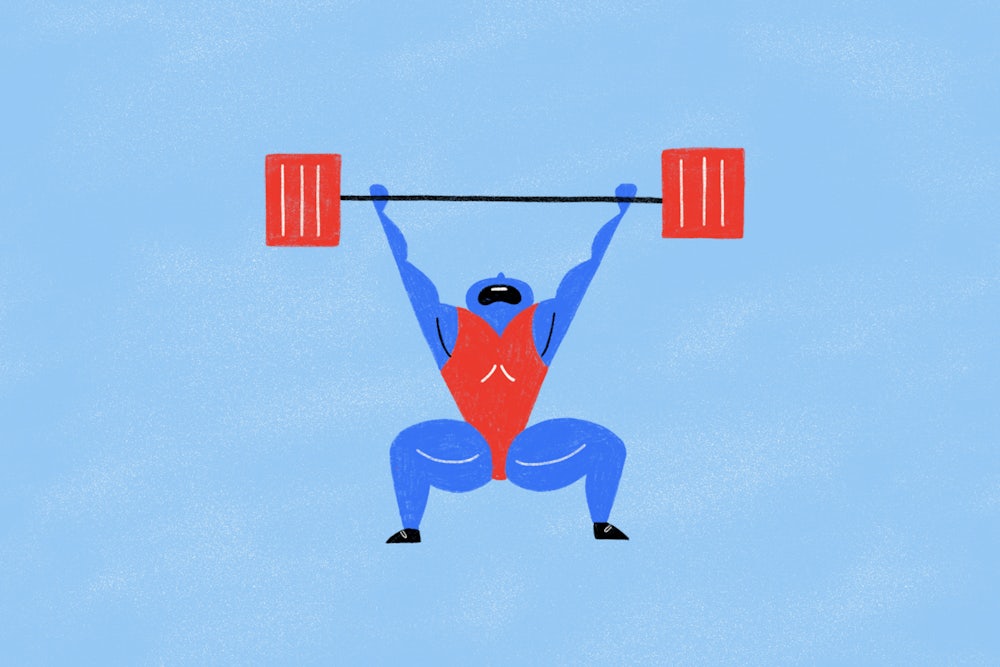
The 1976 Olympics were in Montreal, Canada, and I watched them on TV in Miami with my dad and my two brothers. I was nine years old. My dad was an astonishing athlete and an Olympics fanatic. He had competed in The Commonwealth Games in boxing, hockey, and track-and-field, but his real passion was weightlifting, and that summer we were watching to see if the great Russian lifter Vasily Alekseyev, my father’s hero, could clean and jerk 600 pounds.
Growing up, when I would leave Calgary to visit my father in Miami, the first thing we would do was go to the gym to write up a workout sheet. He kept the photocopies of those sheets until he died, scattering them around his office, in the glovebox of his car, in his workout room at home not far from his bench, and in his locker at the gym.
“Ok, son,” he’d say, sitting on the edge of the mats before we started my first workout since I’d last seen him. “You still doing two sets of fifty pushups? Or should we up that to thee sets? What are you curling now? That’s too much weight for you, son. Let’s lower that weight by twenty pounds and increase your reps. You’re benching 1.5 times your bodyweight. That’s good, but we might lighten that a bit too. There’s no hurry son. It’s better to do it properly. Come on, pay attention, Clance.”
My dad started lifting weights when he was in elementary school, and he had his photo in magazines by the time he was fifteen. He was a bodybuilder as well as a weightlifter and his favorite lift, like most other devotees of the sport, was the clean-and-jerk—the “noble lift” of weightlifting, the acme of the sport. It was a lift I wasn’t even allowed to attempt until I turned thirteen. The most he let me work with about 100 pounds—top 13 year olds these days will clean and press 250 pounds.
There are 12 discrete motions to complete the clean and jerk properly, a bit like learning a short kata in karate. The movement has to be done almost continuously, with a brief pause for a breath when the weight is pressed from a squat or a standing chest-rest, to a standing position extended arm’s length above the head. It’s the event, if you haven’t studied weightlifting, in which, at the end, the lifter releases the barbell from raised above his head, steps back, and it bounces dangerously on the ground.
“Why are the best ones all so fat, Dad?” I asked as we watched TV. “They don’t look like weightlifters.”
“The real lifters have to be, son. You don’t lift that much weight with your arms. It’s your body overcoming the force of gravity. Watch him. He’s not lifting the weight. He’s throwing it above his head. It’s like a discus thrower. Watch how he visualizes the whole lift before he does it. It’s like meditation, son.” In addition to being a weightlifter, my dad was also a New Age guru. “What he’s doing is not physically possible for the human body. But his mind makes it happen.”
We watched as Alekseyev jerked 562 pounds above his head. “What a lift!” my dad said. “He’ll get the gold for that. But he’s not going all the way.” Alekseyev did win gold that year, but the world record remains 580 pounds: Twenty pounds shy of my father’s mythical prediction.
The 2016 Olympics don’t have a super-heavy-weight clean-and-jerk in the class of these 1970s giants, likely due to stricter enforcement of anti-doping regulations. Perhaps the most interesting lifter to watch this year is American Sarah Robles, who lifted 346 lbs in pre-game trials—still about 66 lbs under the women’s record, but formally speaking she is one of the most impressive clean-and-jerk lifters in the sport today. Among the men, 22-year-old Georgian Lasha Talakhadze—who has impeccable form and is one of the prettiest lifters ever—will likely take the gold, with a lift that will no doubt be well under 600 pounds, and may not even reach Alekseyev’s 562.
But the greatest clean-and-jerk I’ve ever seen was when I watched my dad lift 360 pounds in front of a small crowd of admirers at Gold’s Gym in Palm Beach that summer of 1976. Everybody at the gym put down their weights and got up from their benches and stand in a row to watch my dad do it.
He loaded the bar with the great circular weights. He strapped on the wide pale yellow weight belt that went halfway up his back. He chalked his hands. He stepped up to the bar, paused, and visualized the lift, his gaze long and focused. He inhaled, bent at the knees, his slender muscular thin-legged body pulled the bar back and over and suddenly the weight was bouncing up off his pecs, just below the collarbone.
“Come on Billy!”
“Put it in the air!
Then with a clear exhale my dad pushed the bar at full arm length over his head. He caught my eye and smiled. Then he stepped back and let the flexing bar bounce to the mat.
